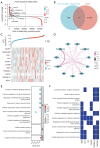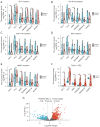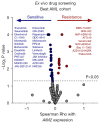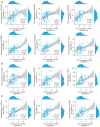FLT3 mutation-related immune checkpoint molecule absent in melanoma 2 (AIM2) contributes to immune infiltration in pediatric and adult acute myeloid leukemia: evidence from bioinformatics analysis
- PMID: 39697705
- PMCID: PMC11651761
- DOI: 10.21037/tcr-24-1403
FLT3 mutation-related immune checkpoint molecule absent in melanoma 2 (AIM2) contributes to immune infiltration in pediatric and adult acute myeloid leukemia: evidence from bioinformatics analysis
Abstract
Background: The use of FMS-like tyrosine kinase 3 (FLT3) as a crucial target for kinase inhibitors is well established, but its association with immune infiltration remains unclear. This study aimed to explore the relationship between FLT3 mutations and immune checkpoint molecules (ICMs) in patients with acute myeloid leukemia (AML).
Methods: The Cancer Genome Atlas (TCGA) and Genotype-Tissue Expression (GTEx) databases were used to identify the ICMs associated with FLT3 mutations. A Gene Ontology (GO) analysis, Kyoto Encyclopedia of Genes and Genomes (KEGG) analysis, and gene set enrichment analysis (GSEA) were conducted to analyze the signaling pathways related to the ICMs. The single-sample GSEA (ssGSEA), Cibersort, and estimate algorithms were used to assess immune cell infiltration in AML.
Results: Absent in melanoma 2 (AIM2) exhibits elevated expression levels in AML patients harboring FLT3 mutation, contributing significantly to the progress of AML and establishing of an immunosuppressive microenvironment. AIM2 expression significantly correlated with sensitivity of clinically relevant drugs in ex vivo assays of AML. Additionally, AIM2 demonstrates substantial prognostic value and holds promise as a prospective immunotherapeutic target for AML. Our findings indicate a significant correlation between AIM2 and immune infiltration in AML cases, potentially affecting the presence of neutrophils, macrophages, effector memory T cells (Tem), and monocytes. Furthermore, AIM2 is closely linked to various signaling pathways, such as immune cytokine release, immune antigen presentation, and inflammasome signaling, which could play a role in immune cell enrichment in AML.
Conclusions: Our study identified AMI2 as an ICM linked to FLT3 mutations. AMI2 may be involved in the activation of suppressive immune cell populations, such as macrophages, neutrophils, and monocytes. AIM2 could serve as a promising immunotherapeutic target for combination therapy with FLT3 inhibitors in AML.
Keywords: Acute myeloid leukemia (AML); FMS-like tyrosine kinase 3 (FLT3); absent in melanoma 2 (AIM2); immune checkpoint; immune infiltration.
2024 AME Publishing Company. All rights reserved.
Conflict of interest statement
Conflicts of Interest: All authors have completed the ICMJE uniform disclosure form (available at https://tcr.amegroups.com/article/view/10.21037/tcr-24-1403/coif). J.A.M.N. serves as an unpaid editorial board member of Translational Cancer Research from September 2023 to August 2025. The other authors have no conflicts of interest to declare.
Figures









Similar articles
-
Identification of the key genes and microRNAs in adult acute myeloid leukemia with FLT3 mutation by bioinformatics analysis.Int J Med Sci. 2020 May 18;17(9):1269-1280. doi: 10.7150/ijms.46441. eCollection 2020. Int J Med Sci. 2020. PMID: 32547322 Free PMC article.
-
High FLT3 expression indicates favorable prognosis and correlates with clinicopathological parameters and immune infiltration in breast cancer.Front Genet. 2022 Sep 8;13:956869. doi: 10.3389/fgene.2022.956869. eCollection 2022. Front Genet. 2022. PMID: 36159964 Free PMC article.
-
Integrated bioinformatics and functional studies identify CDK9 as a potential prognostic biomarker and therapeutic target in AML.Discov Oncol. 2025 Jun 9;16(1):1038. doi: 10.1007/s12672-025-02841-4. Discov Oncol. 2025. PMID: 40490668 Free PMC article.
-
Targeting FMS-like tyrosine kinase 3 (FLT3) in acute myeloid leukemia: Novel molecular approaches and therapeutic challenges.Biomed Pharmacother. 2025 Jan;182:117788. doi: 10.1016/j.biopha.2024.117788. Epub 2024 Dec 28. Biomed Pharmacother. 2025. PMID: 39733588 Review.
-
Prevalence and Clinical Outcome of FMS-Like Tyrosine Kinase Mutations Among Patients With Core Binding Factor-Acute Myeloid Leukemia: Systematic Review and Meta-Analysis.Clin Lymphoma Myeloma Leuk. 2022 Apr;22(4):e221-e232. doi: 10.1016/j.clml.2021.09.020. Epub 2021 Oct 2. Clin Lymphoma Myeloma Leuk. 2022. PMID: 34750085
References
LinkOut - more resources
Full Text Sources
Miscellaneous
